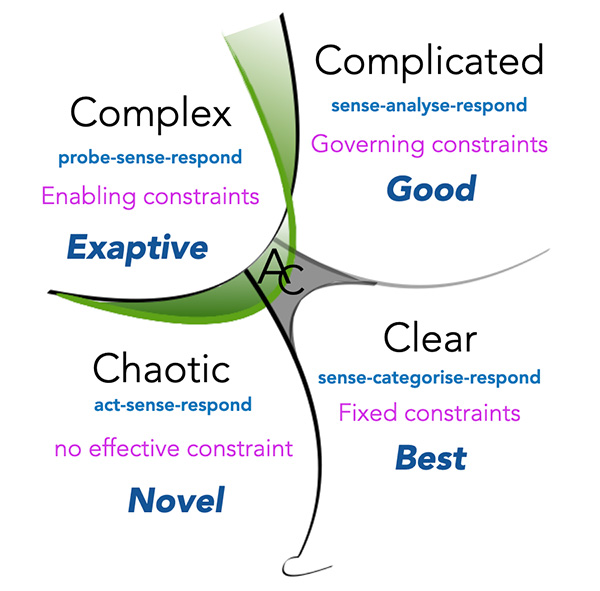7 facilitation tips to start your Scrum Team
Agile Metrics : Agile Health Metrics for Predictability
Cynefin framework

The Cynefin framework is a sense-making tool that provides a common language for groups to identify the levels of certainty in the environment. It has five domains, with the central one representing “when we do not know where we are” (the AC refers to Aporetic or Confused). The main value comes from the conversations in understanding which of the other four domains we are working in:
- The Clear domain is where we can have one best practice. We should be able to look up the decision somewhere and get a predictable outcome.
- The Complicated domain is one of expertise. There are often several good options, and the right subject matter experts can guide the decision to a good outcome.
- The Complex domain means we cannot predict the outcome. We will need to navigate the environment and take an exploratory approach to influence our decision-making. This is where being partially correct shines, and we must be comfortable with the ambiguity that ensues. When we cannot predict an outcome, the attempt to gain certainty before we make a decision is costly and futile. This is the key reason for taking a test-and-learn (partial correctness) approach. How can we make the decision in a way that makes it safe to learn while helping us avoid bad unintended consequences? (Good unintended consequences are fine and should be amplified.)
- The Chaotic domain is where decisions are required very quickly, and the main aim is to control the environment and prevent further bad things from happening.
Backlog Refinement Single Team Scrum
How DropBox Started As A Minimal Viable Product
Avoid using Blocked columns on Kanban Boards`
Radical Product Thinking
Lean and Agile are like a fast car, it helps you iterate faster, but it does not give you a clear vision and strategy.
Most companies run into Product Diceases:
- Strategic Swelling: The product tries to do too much for too many users – unfocused efforts, weak value proposition.
- Obsessive Sales Disorder (OSD): Features delivered for individual customers – fragmented product, distracted engineers.
- Narcissus Complex: Looking inwards and focusing on our own needs – disconnected from customer needs.
- Hypermetricemia: Obsession with metrics and analytics – incremental product improvement, stuck in local maxima.
And have Digital Pollution: Collateral damage from our products.
A good vision is not a short slogan or BHAG. Your vision should articulate:
- Who: Whose world are you changing?
- What: What does their world look like today?
- Why: Why does their world need to change?
- When: When will you know that you’ve arrived?
- How: How are you going to change it for them?
Product Strategy (RDCL):
- Real Pain Points – What do businesses need in the oasis?
- Design – What does our solution look like?
- Capabilities – How do we enable those capabilities?
- Logistics – How do we deliver it?
Radical Product helps you define and communicate what you are building and why.
Lean and Agile help you execute, learn and iterate under uncertainty.
Navigating Complexity aka Cynefin for Dummies

